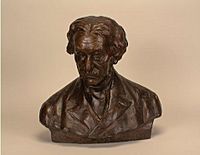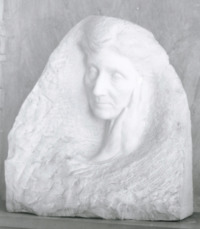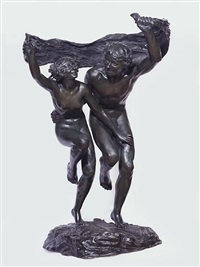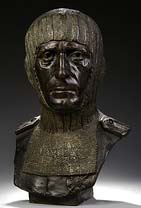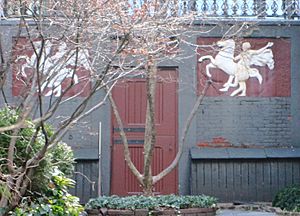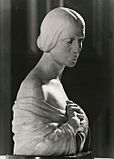Malvina Hoffman facts for kids
Quick facts for kids
Malvina Cornell Hoffman
|
|
|---|---|
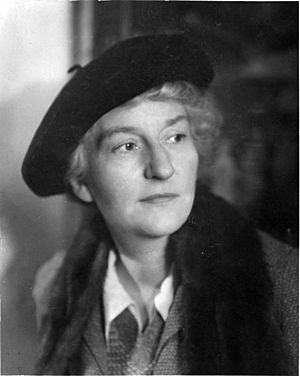
Roger Parry, Malvina Hoffman, c. 1920, from the Smithsonian Photography Initiative.
|
|
| Born | June 15, 1885 New York City, US
|
| Died | July 10, 1966 (aged 81) New York City, US
|
| Education |
|
| Known for | Sculptures of dancers and "Hall of Man" at the Field Museum of Natural History |
|
Notable work
|
|
| Spouse(s) | Samuel Bonarios Grimson (1924–1936) |
Malvina Cornell Hoffman (June 15, 1885 – July 10, 1966) was an American sculptor and author. She was famous for her amazing life-sized sculptures of people made from bronze. She also worked with plaster and marble.
Hoffman created sculpted portraits of everyday people and important figures. She was especially known for her sculptures of dancers, like Anna Pavlova. Her sculptures of people from different cultures, called "Hall of Mankind", were a popular exhibit at the Field Museum of Natural History in Chicago. This collection was also shown at the Century of Progress International Exposition, a big fair in Chicago in 1933.
She was asked to create sculptures for monuments and won many awards. These included being a member of the National Sculpture Society. In 1925, she joined the National Academy of Design and became a full member in 1931. Many of her portraits are kept at the New-York Historical Society. She also hosted social gatherings for artists and friends at her studio in Sniffen Court Historic District for many years.
Malvina Hoffman was very skilled in how bronze sculptures are made. She often cast her own artworks. In 1939, she published an important book about the history and techniques of bronze casting, called Sculpture Inside and Out.
Contents
Early Life and Art Studies
Malvina Hoffman was born in New York City on June 15, 1885. She was the fourth of six children. Her father, Richard Hoffman, was a concert pianist and composer. Her mother, Fidelia Marshall Hoffman, was also a pianist. Malvina's mother taught her at home until she was 10 years old.
The Hoffman family often invited artists and musicians to their home. When Malvina was young, she met Swami Vivekananda, a spiritual leader, who lived and taught in New York City. Some of her later sculptures, like one of Sri Ramakrishna, are at the Ramakrishna-Vivekananda Center in New York.
Malvina attended several private schools, including Veltin School for Girls, Chapin, and Brearley. While at Brearley, she took evening art classes at the Woman's School for Applied Design and the Art Students League of New York.
She studied painting with John White Alexander in 1906. She also learned from Harper Pennington. Hoffman improved her art skills by studying with sculptors like George Grey Barnard, Herbert Adams, and Gutzon Borglum. In 1907, she worked as an assistant to sculptor Alexander Phimister Proctor in his studio. In 1908, Hoffman traveled to Paris with Katharine Rhoades and Marion H. Beckett to study art.
In 1909, she created a sculpture of her father's head, which was her first finished piece. This was just two weeks before he passed away. It was shown at the National Academy the next year. In 1910, she won an award for a sculpture of Samuel Grimson, who would later become her husband. Hoffman loved sculpture because it gave her artistic freedom to create three-dimensional art.
After her father's death in 1910, Malvina and her mother moved to Europe. They first visited London and saw a ballet performance that inspired Hoffman. She was amazed by the dancers Mikhail Mordkin and Anna Pavlova. Mother and daughter then visited Italy before moving to Paris.
In Paris, Malvina worked as a studio assistant for Janet Scudder. At night, she studied at Académie Colarossi. She tried five times before being accepted as a student by the famous sculptor Auguste Rodin. He told her, "Do not be afraid of realism," meaning she should sculpt things as they truly are. In 1912, she traveled to Manhattan to study anatomy at Columbia University to better understand the human body for her art. From her teachers, she learned about bronze casting and finishing. The Hoffman women lived in Paris until World War I began in 1914.
Sculpting Career
Dancers and Early Works
Malvina Hoffman became famous worldwide for her sculptures of ballet dancers. Dancers like Vaslav Nijinsky and Anna Pavlova often posed for her. In 1911, she created Russian Dancers, which was shown at the National Academy. She also made a plaster sculpture of Pavlova in 1923. Hoffman created artworks that captured the graceful movements of dancers. In 1912, she made Bacchanale Russe. A version of this sculpture won an award in 1917, and a larger one was displayed in Paris in 1918. Some people called her "America's Rodin" because of her talent.
World War I Efforts
During World War I, Hoffman helped organize a French charity called Appui aux Artistes to help artists in need. She also created a relief fund for children in Yugoslavia. While working for the Red Cross, Hoffman traveled to Serbia. There, she made a large sculpture of Croatian sculptor Ivan Meštrović, with whom she also studied.
Her sister, Helen, worked with the Red Cross, which sent supplies to Serbia. Through her sister, Malvina met Serbian Colonel Milan Pribićević in 1916. He gave powerful speeches in the United States, asking Serbians to help their homeland. Hoffman was inspired by strong, charismatic people. She once said, "Hero worship formed a major part of my emotional life." Colonel Pribićević posed for her sculpture called A Modern Crusader (1918). This sculpture showed him looking tired but determined. Copies of this work are at the Metropolitan Museum of Art, Smithsonian American Art Museum, and Art Institute of Chicago.
She also designed a well-known poster that said "Serbia needs your help". It was based on a photo of Serbian soldiers who had died from hunger. Hoffman made the soldier look "alive" on the poster. In 2018, an exhibition about Malvina Hoffman was held in Novi Sad, Serbia. It showed her drawings from her visit to Serbia in 1919. She wrote about her experiences in Serbia in her book Heads and Tales.
Between the World Wars
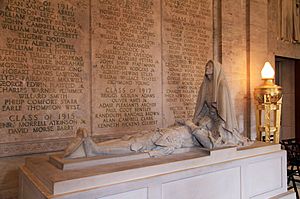
In 1919, she created a large sculpture for the front of Bush House in London. That same year, she was in Paris cataloging the works of Rodin for the Musée Rodin. In 1929, her first big art show took place at the Grand Central Art Galleries. It featured 105 of her artworks.
After the war, she met American Red Cross worker John W. Frothingham and his Serbian wife, Jelena Lozanić. Hoffman and Lozanić continued to help Serbia (now part of Yugoslavia) by giving talks about orphaned Serbian children. She also welcomed Croatian sculptor Ivan Meštrović and let him use her studio. In 1919, at the request of Herbert Hoover, Hoffman traveled to Serbia and Yugoslavia to visit humanitarian missions. She also visited the site of the 1389 Battle of Kosovo.
After the war, she created the sculpture The Sacrifice. It was dedicated in 1923 at the Cathedral of St. John the Divine in New York. This sculpture honored Harvard University alumni who died in the war. It was later moved to the Memorial Church at Harvard University in 1932.
Hall of Mankind
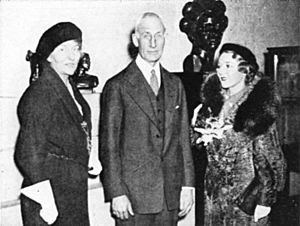
In 1929, Malvina Hoffman received a telegram from Stanley Field, who was the director of the Field Museum of Natural History in Chicago, Illinois. He asked her to create sculptures of people from different nationalities and races from around the world. Hoffman traveled globally, visiting places like Africa, India, and Bali, from 1931 to 1932. During her travels, she created sculptures of people and took over 2,000 photographs.
She completed more than 105 sculptures, mostly in bronze, but also in marble and stone. These included sculptures of heads and full figures of individuals. They were displayed in the museum's Hall of Mankind in 1933. She wrote about her travels for this project in her book, Heads and Tales. The exhibit was very popular. However, some people later questioned if the sculptures truly represented different groups of people fairly. The Hall of Mankind was removed in 1969, but some of the sculptures are still shown today.
In 2016, fifty sculptures from the Mankind collection were displayed again at the museum. This exhibition was called "Looking at Ourselves: Rethinking the Sculptures of Malvina Hoffman."
World War II Efforts
Just like in World War I, Hoffman helped the Red Cross during World War II. She raised money for the Red Cross and for national defense. She also continued to support Serbia, which was occupied by Germany again. She worked with New York City's mayor, Fiorello La Guardia, and Jelena Lozanić to send aid to the occupied areas.
In 1948, Hoffman created relief sculptures for the walls of the American World War II Memorial. This memorial is at the Epinal American Cemetery and Memorial in Vosges, France. It is located near the site of the Battle of the Bulge (1944). There are 5,255 American soldiers buried in this cemetery.
Other Works and Awards
Malvina Hoffman created a 13-panel sculpture showing the history of medicine for Boston's Joslin Clinic. She also made portrait sculptures of famous people like John Muir, Wendell Willkie, Ignacy Jan Paderewski, and Henry Clay Frick. Her artworks were often shown at the National Academy. In 1965, she published another book called Yesterday is Tomorrow.
She received many awards for her art. These include a gold medal in 1924 from the National Academy. In 1962, she won a gold medal for her sculpture Mongolian Archer. In 1964, she received a gold medal from the National Sculpture Society. She was also given five honorary doctorates. For her public service, she received the French Legion of Honour and the Royal Order of St. Sava III of Yugoslavia.
Her art is part of the permanent collections in many museums around the world. These include the Metropolitan Museum of Art, the Detroit Institute of Arts, the Santa Barbara Museum of Art, and the Smithsonian American Art Museum.
Personal Life
Malvina Hoffman married Samuel Bonarius Grimson on June 4, 1924. He was an Englishman whose career as a concert violist ended due to injuries during World War I. After the war, he collected old paintings and instruments. He also invented a part for color televisions. He traveled with Malvina when she searched for models for her "Hall of Mankind" sculptures. Hoffman and Grimson divorced in 1936.
Hoffman was friends with painter Romaine Brooks, writer Gertrude Stein, and ballet dancer Anna Pavlova. She often hosted costume parties and balls at her studio, which were mentioned in the city's society news. She also spent summers at a cottage in Hartsdale.
Malvina Cornell Hoffman passed away from a heart attack in her Manhattan studio on July 10, 1966.
Images for kids
-
Boy and Panther Cub, 1915, Museum of Art Cedar Rapids, Iowa
See Also
 In Spanish: Malvina Hoffman para niños
In Spanish: Malvina Hoffman para niños


